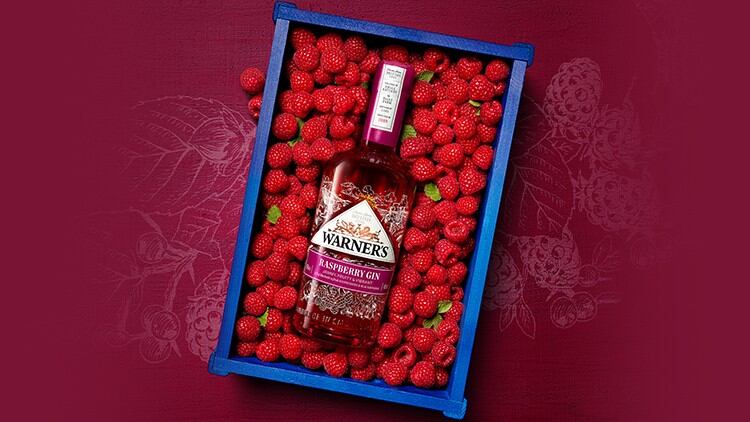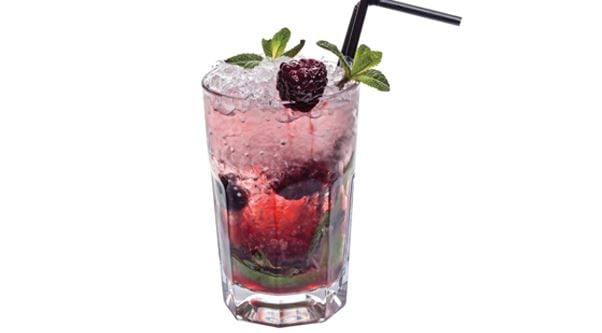Anyone who predicted a slowdown of gin sales in the on-trade can stop reading now because the category has gone from strength to strength and looks set to continue doing so.
ADVERTISEMENT
Warner's Gin delivers flavour

It’s dirty hands, hard work, full hearts, and a deep love of the land. It’s coming to work every day with a smile on your face and a fire in your belly to make uncompromising, epic gin. Real craft means graft. Real craft keeps you humble.
We started in 2012 on our beautiful family farm, with no idea what we were getting ourselves into. We began with the things that matter most and a dream to save the world from mediocre gin. We ended up stripping the industry back to its roots: we became gin farmers.
We draw water from our spring, grow the botanicals, and collect fresh honey from our own beehives. We try to keep things local and, as custodians of the land, we harvest with a respect for nature and the community. As we go, we try to give back more than we take: re-sow, replant, rebuild.
Only the population’s love of the spirit can account for gin’s sensational year-on-year rise. And this love doesn’t appear to have reached its peak yet, as new regional distilleries continue to launch. Between 2010 and 2016, according to HMRC, there was a 135% rise in numbers of UK distilleries (not just gin), from 116 to 273.
Scotland, unsurprisingly, has always dominated the market with the largest number of distilleries in the UK – 131 as of 2016 – compared with Northern Ireland which has 11, Wales with 13 and England at 118. The largest total rise in the number of distilleries was in 2015, when 49 (27%) were launched.
It isn’t possible to say how many of those distilleries produce gin because it is not necessary to specify what you are making when applying for a distillery license, but spirits experts claim gin will be a large proportion.
Wine & Spirit Trade Association (WSTA) chief executive Miles Beale says: “Gin in the on-trade has grown by 12% by volume in the past year to 56,000hl (8m bottles) worth £655m.”
According to Beale, consumers do not necessarily discriminate between local or major brands when it comes to gin, yet he does recognise the proliferation of small-batch distilleries and their importance in the category.
He adds: “Consumers are increasingly interested in the locality, provenance and authenticity of what they are drinking. Distilleries are producing and marketing their products to reflect this trend.”
Driving innovation
Arguably, it is these niche producers that are driving innovation in the category, as smaller batches make it easier to play around with new flavour profiles. Also, local makers are able to reflect the terroir of their regions by using the botanicals associated with them, details which consumers lap up with excitement.
“Spirits such as gin, with its range of botanicals, are attractive to consumers who have increasingly sophisticated palates. In the past, people were less concerned about where a gin came from or what botanicals it used. Now, consumers are more interested and it can influence choice.”
But this proliferation does not necessarily mean all gins produced in the UK will stay here and be consumed by Brits. The latest HMRC figures also show exports of gin are worth around £500m, which is predicted to shoot up another 32% in the next five years.
Super-premium segmentation
Several words come to mind when thinking of local gins, such as premium or super-premium – generally meaning they command a higher price point. But this segmentation is too simple for an ever-expanding category.
ADVERTISEMENT
Sipsmith Gin delivers its journey
The humble gin and tonic; what can go wrong and what more can be done to such a simple drink? The answer to both questions is, actually, quite a lot.
The difference between an outstanding G&T and a terrible one is the way the ingredients are used and in what proportions. Even a basic one can be made great by using the right quantity of ice, a garnish and topping with the perfect amount of tonic.
Here we’re showing you how to serve two perfect G&Ts, as well as a rhubarb and ginger by using Fever-Tree mixers.
The trick to the best-looking and best-tasting long gin drink is starting with a large glass full of ice and topping with Fever-Tree, which allows the gin to shine through, without unbalancing the drink.
Finally, an eye-catching and fragrant garnish will get the drinker excited, as well as other customers in the vicinity.
According to Wayne Scrivener, general manager of online drinks distribution firm Ooberstock, gin is expanding further into locality, as makers seek to give consumers new experiences.
“With drinkers open to and seeking new gin ‘experiences’, there is an opportunity to extend or segment the range across brand origin, ingredients, process and taste profiles,” he says.
Two smaller brands Scrivener is focusing on include Blue Bottle, a 47% ABV boutique, distilled gin from the Three Fingers Distillery in Guernsey, and Crafter’s London Dry Gin, which is a 43% ABV gin made in small batches using Nordic botanicals.
A wider interest in different botanicals and flavours is summarised by Hi-Spirits managing director Dan Bolton, who believes there is no longer a one-size-fits-all approach. Stock the mainstream and the premium gins, which are familiar to consumers, but the local and craft are growing in importance, he says.
Although, he warns to “rotate rather than proliferate”, and adds: “Provenance is important as consumer interest in craft brands is growing, but it needs to be in an on-trade context. Consumers go out to pubs and bars to meet friends and enjoy themselves, so the focus needs to be on offering interesting and engaging serves.”
Bolton advises pubs to use their gins – whether local or not – in more than just a gin and tonic, adding consumers may be keen to try cocktails that make use of the botanicals of the various brands. This is something bar equipment supplier Parsley in Time marketing manager Rob Blunderfield agrees with, but only to a certain extent.
“As new artisan distillers emerge, new cocktails get dreamt up and new ways to present them abound,” he explains. “Despite this, the classic gin and tonic is still the most popular. To make the perfect G&T, you need a good-quality gin and a good-quality tonic served with a garnish and ice – but just as important as the drink itself is what it is served in.”
Although Blunderfield has an ulterior motive – in that his company sells glassware – he is right, the glass plays a big part in swaying a consumer to buy a drink. According to TNS Omnibus’ 2012 Perfect Serve survey, 30% of consumers would buy more drinks in a venue if they were served better. The same research revealed 78% of consumers said that, aside from taste, presentation is what makes the perfect serve.
Locality grows in importance
But, getting back to the topic in hand, locality is growing to be so important that Hayman’s Gin has unveiled plans to move its family distillery back to London. Its new distillery will be installed within a period brick warehouse in Balham, south-west London, with the first batches of its London Dry Gin set to come off the stills in autumn this year.
ADVERTISEMENT
Brockmans Blackberry Sling

Brockmans Blackberry Sling
Glass: Highball
Ingredients:
- 50ml Brockmans gin
- 50ml lime juice
- 25ml sugar syrup
- Soda water
- 10 Fresh blackberries
- Rosemary sprigs
Method: With an eye on the autumn, this is a signature serve from Brockmanns, which has blackberries in its botanical bill. Muddle the blackberries and a sprig of rosemary in the glass. Remove the rosemary and add the gin, lime juice and sugar. Stir, then add ice and top with soda. Garnish with more blackberries and a fresh sprig of rosemary.
Degree of difficulty: Intermediate
Fifth generation distiller Christopher Hayman says: “I’ve made no secret over the years of my ambition to move distillation of our range of English gins back to London. After several years of growth and interest in our story, I’m delighted we’re now at the stage where this has become a real possibility.”
Yet, the story isn’t the only part that makes a product of interest to consumers, tempting them with new and unique flavour profiles is also an important part of the offer.
The rise of gin liqueurs
Small-batch craft gin maker the Durham Distillery recently launched a Strawberry & Pink Pepper liqueur using its Durham Gin.
Liqueurs made using gin are also on the rise, as distillers seek new ways to engage with existing and potential customers. For instance, Edinburgh Gin recently added a plum & vanilla flavoured gin liqueur to its already three-strong range.
Durham Distillery founder and owner Jon Chadwick says: “We produce gin and vodka with genuine integrity – hand-crafting small batches using traditional methods and excellent ingredients, by people who are truly passionate and knowledgeable about what they’re doing.
“We’re a small operation, so don’t have to sell millions of litres annually to break even, our aim is offering a quality and delicious product to the discerning gin drinker – those who may drink less, but better.”
Others including unique flavours in their distillations, though not a gin liqueur, include the newly launched Jindea brand, which uses single-estate Indian Darjeeling tea, proving a locally inspired gin with an interesting story does not just have to come from around the corner.
Director of the brand Matthew Dakers, along with fellow business partners Jack Rackham and Adrian Gomes, were all inspired by their families’ links to India.
“Both myself and Adrian have strong ties to the continent. My grandfather was born in India and my great-grandfather served as an Indian Army captain. Adrian’s father grew up in Goa where his family worked on the railways.”
To take the brand from conception to production, the trio enlisted tea sommelier Ajit Madan of London-based Camellia’s Tea House. Dakers adds: “Darjeeling tea imparts aromas of Muscat grape and stone fruits. It is known as the ‘Champagne of teas’ and the picturesque tea gardens of Darjeeling, at the foot of the Hima-layas, produce less than 1% of India’s total tea production.”
Authentic brand stories
As the market continues to grow, it is likely more unique botanicals and flavoured liqueurs will be launched. A spokesperson at Halewood Wines & Spirits says: “Consumers are, more than ever, looking for authentic brand stories, a trusted and desired brand is no longer just name recognition, people are looking for a deeper connection and point of difference.”
There is no doubt this year that craft gin will continue to grab consumer interest, with Campari UK marketing director Nick Williamson believing craft British gins will become more popular than ever.
“The craft gin movement in particular looks certain to maintain its popular status in 2017 as consumers continue to explore new ways to enjoy gin, either sipping it neat, on the rocks or in gin-based cocktails,” he says.
It would appear the future of gin is small, in that craft and local will be a big part of what consumers want to see in the on-trade. And that said, if you did not turn the page when earlier warned, perhaps you will now see gin’s demise is miles off.
